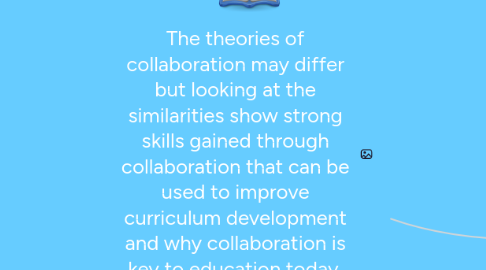
1. Theories of Collaboration
1.1. Differences
1.1.1. Has Individual First and Team First categories divided into themes. Individual first's themes are turn-taking, observing or doing, and status seeking. Team First's themes are influencing others, organizing work, and building group cohesion. (Theory et al., 2014, p. 63)
1.1.2. Made up of collaborative teams that focus their efforts on critical questions they need to answer as educators. (Dufour, 2007, p.5)
1.1.3. Teacher's collaborate with no face-to-face interaction, it is at teacher's convenience, and it supports many-to-many communications.
1.1.4. Collaborative Peer Learning is just two students working together with an adult.
1.2. Collaborative Peer Learning 2:1 Model (Lynam, Corish, & Connolly, 2015, p. 171)
1.3. Online Collaboration (Seo & Han, 2013, p. 225)
1.4. Collaboration Theory (Theory, Colbry, Hurwitz, & Adair, 2014, p. 63)
1.5. Professional Learning Communities (Dufour, 2007, p. 5)
1.6. Similarities
1.6.1. Powerful tool
1.6.2. Increased time for reflective practice
1.6.3. Increase positive interdependence
1.6.4. Social support
1.6.5. Improves student achievement
2. Effective Group Practices in Educational Setting
2.1. Group Practices Used in Educational Setting
2.1.1. Contrived Collegiality, or mandated collaboration is enforced in my educational setting. We have to collaborate every day for at least 30 minutes in the morning, we also have cluster which is embedded Professional development weekly for an hour, and data review for 30 minutes weekly. I find it helpful but I also feel like Seo and Han, 2013 describe when they mention that it stifles voluntary collaboration. I spend so much of my time forced to collaborate that when I'm outside that mandated time I just rush trying to accomplish all my other tasks.
2.1.2. Active participation of staff is something that happens regularly in my educational setting. We have collaboration every morning, embedded PD weekly, and Data meetings weekly and for the most part everyone is actively participating in whatever our assigned topic is during that time. There is an activity or task for the staff to be actively engaged in some examples of this in my educational setting are jigsaw of an article, graphic organizers, and presenting out information to the group.
2.1.3. Turn Taking is something that works well in my educational setting as we communicate while collaborating (Theory et al, 2014). We have norms for staff meetings and one norm is that we listen to each other when we speak. We are very informal and raise our hands to speak in large group and just take turns naturally in small groups.
2.2. Group Practices Not Used in Educational Setting
2.2.1. Building group cohesion is something that I haven't seen at my school. I have seen some grade levels work together to build cohesion but I haven't seen it as a goal from our administrator and I feel cohesion between grade levels would be helpful as well. (Colbry et al., 2014) I am currently a Kindergarten teacher and as of right now I don't know any of the 1st grade teacher's names. I feel if we had more group cohesion and Kindergarten met with 1st grade and even 2nd at times to discuss skills and students vertically it would help the collaborative and curriculum of our school.
2.2.2. Organizing work is something I have noticed that doesn't happen like it should in my educational setting (Colbry et al, 2014). If our principal doesn't assign us tasks or give explicit instructions for how to accomplish the task for the day teachers tend to do their own tasks and the collaboration falls through that day. This doesn't happen much for planned meetings but the daily collaboration has begun to turn into us individually working on getting ready for the day instead of the well intended collaboration time that we have to plan our curriculum with our grade team.

